MARIANI’S
Virtual Gourmet
JULY 26,
2015
NEWSLETTER
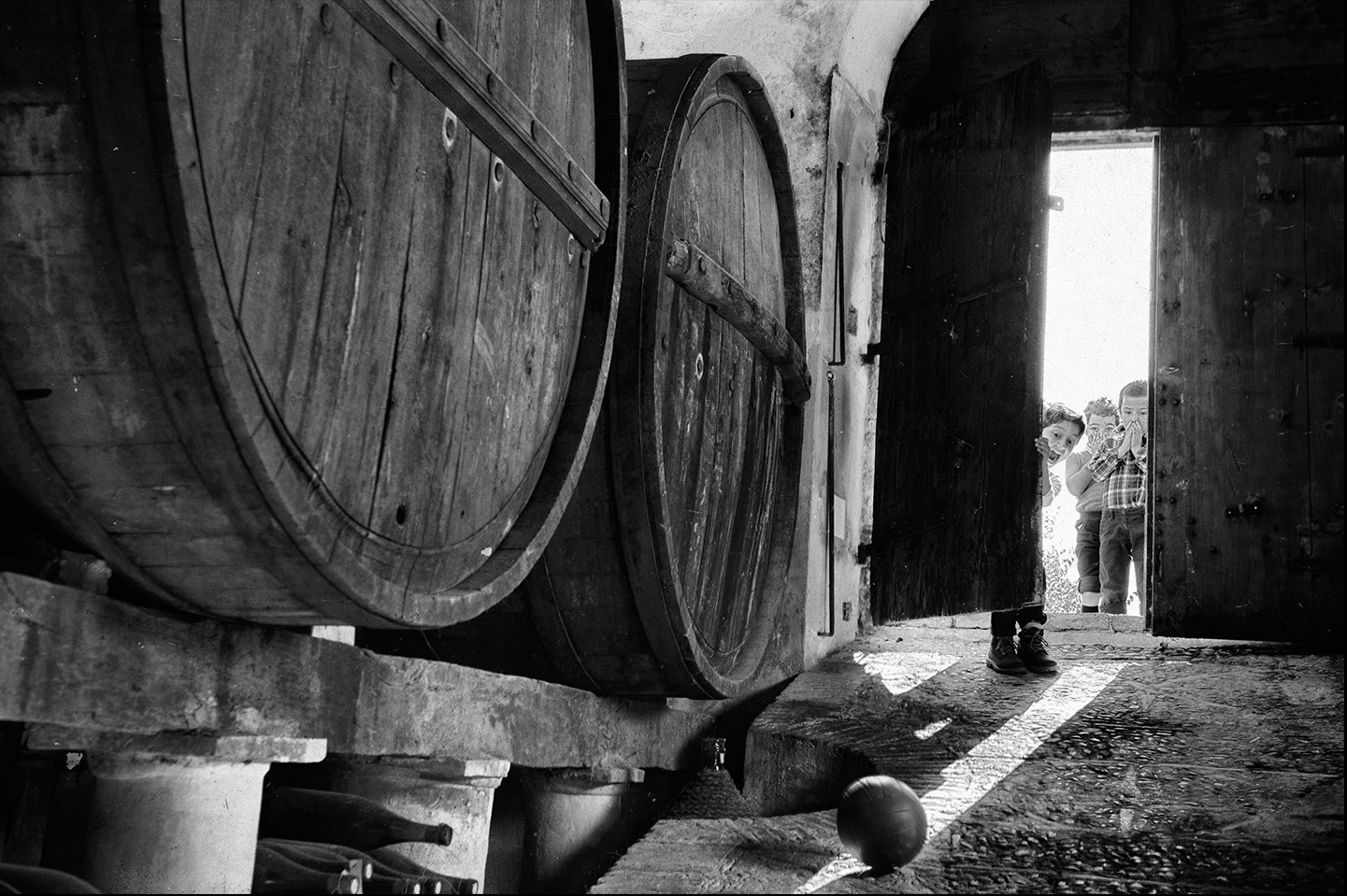
Masciarelli
Winery, Abruzzo, Italy
IN THIS ISSUE
NASSAU NOW
BY Dotty Griffith
NEW YORK CORNER
STREETBIRD ROTISSERIE
By John Mariani
NOTES FROM THE WINE CELLAR
PINE RIDGE BRINGS ITS WINES TO NYC
By Mort Hochstein
❖❖❖
NASSAU NOW
BY Dotty Griffith
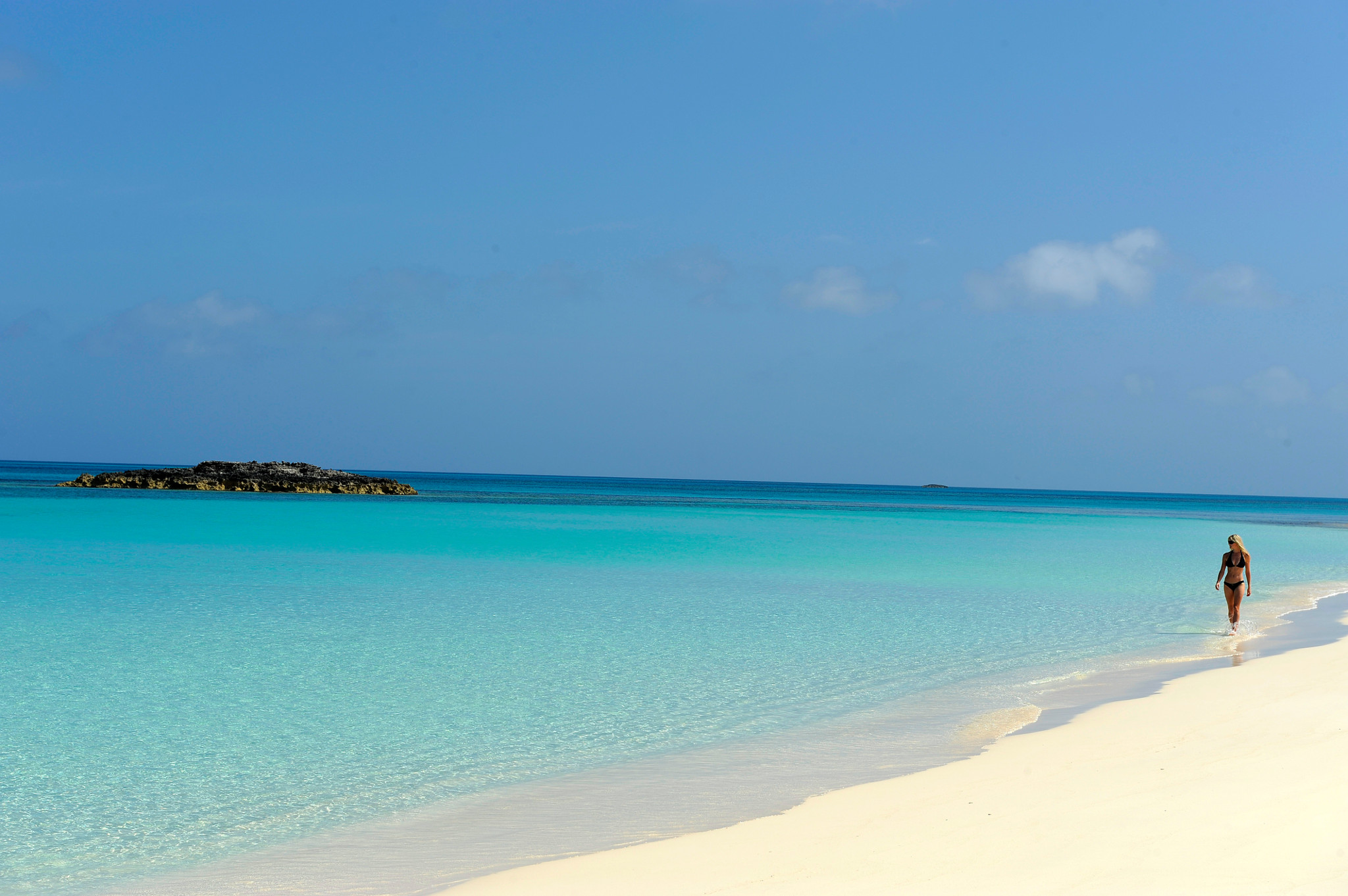
If
you’re a fan of Black Sails,
you know it’s in reruns until season three
starts early next year. The Starz network
historical drama about real pirates of the
Caribbean, set in Nassau as a prequel to Treasure
Island, has me hooked. So does the real
Nassau of today. Though the swashbuckling days
are long gone, the beauty of the island with its
crystalline beaches, the bluest of water and an
intoxicating mix of native, historic and
contemporary influences gives Nassau its charm
and vibrancy.
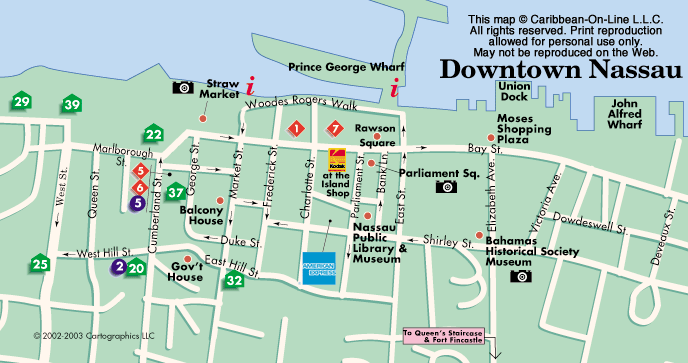 The food is just
as intriguing--a mix of today and long ago, upscale
and street scene, indigenous and colonial. Influences
include Spanish, West African and British culinary
traditions. Dine at casual beachfront cafés,
celebrity chef restaurants, fast-food spots, seaside
bars and grills as well as world-renowned resorts.
The food is just
as intriguing--a mix of today and long ago, upscale
and street scene, indigenous and colonial. Influences
include Spanish, West African and British culinary
traditions. Dine at casual beachfront cafés,
celebrity chef restaurants, fast-food spots, seaside
bars and grills as well as world-renowned resorts.
Hilly Nassau is the capital and largest city
of the Bahamas. It lies on the island of New
Providence, with neighboring Paradise Island
accessible via Nassau Harbor bridges. It retains
many of its characteristic pastel-colored British
colonial buildings, including pink-hued Government House.
Restaurants and accommodations run a wide gamut,
from luxe resorts to historic properties. So, too,
do the food options.
At a
resort like Sandals
Royal Bahamian, guests may dine in flip flops at
casual venues or in resort evening attire at Gordon’s on the Pier, where your table
overlooks the water (right). Available to guests in
butler suites (or for $140 surcharge), Gordon’s is
one of the most romantic and beach breezy
experiences at this resort. Rillettes of
smoked salmon, mahi mahi and trout served with
garlic crostini teased the appetite
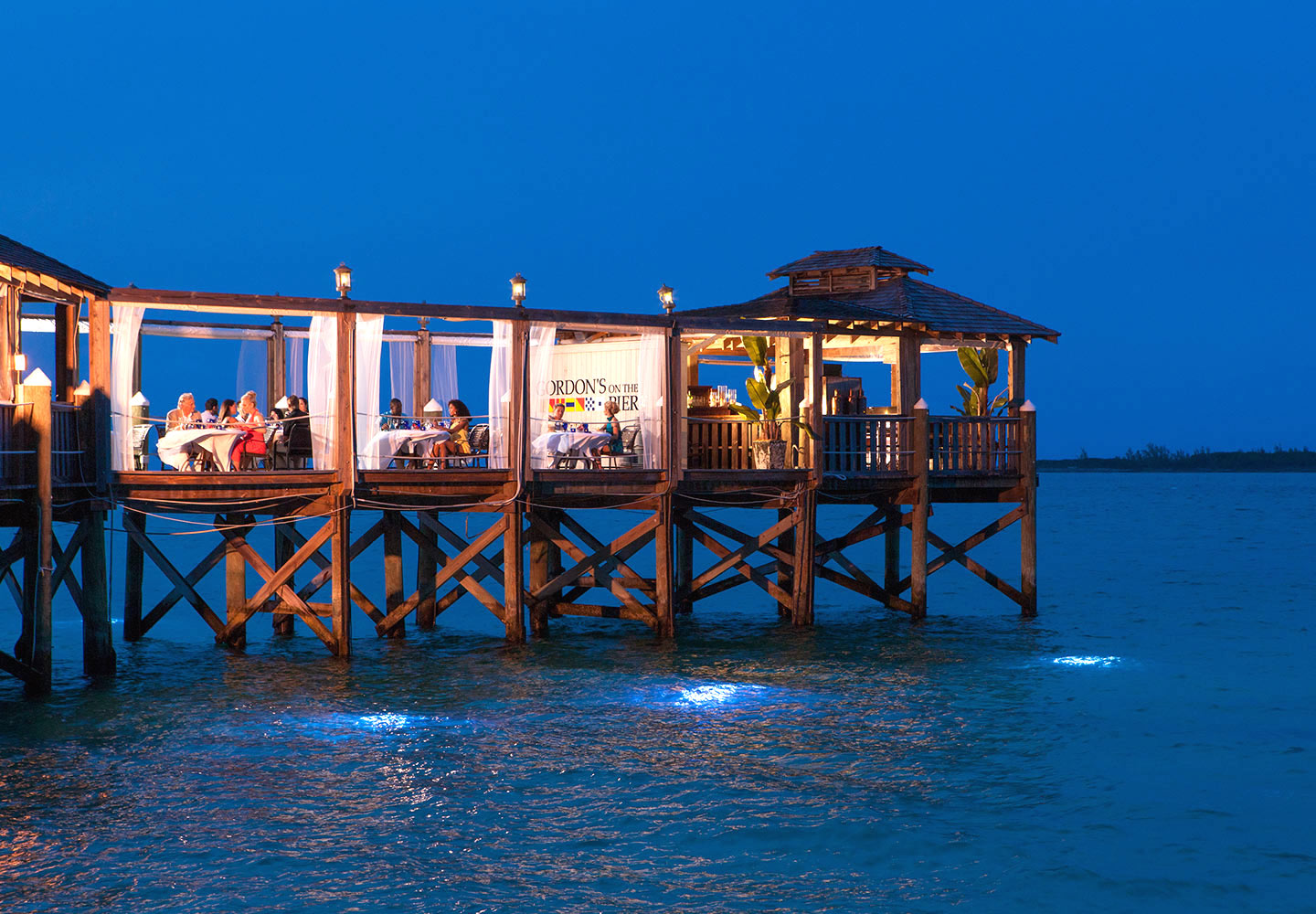 before we dined in the Crystal Room
on braised lamb shank and herb-crusted rack of
lamb. We took dessert, molten chocolate cake with
Bailey’s vanilla ice cream, at the fire pit under
vibrant stars in the Caribbean sky.
before we dined in the Crystal Room
on braised lamb shank and herb-crusted rack of
lamb. We took dessert, molten chocolate cake with
Bailey’s vanilla ice cream, at the fire pit under
vibrant stars in the Caribbean sky.
A can’t-miss feature of a trip to Nassau is the Tru Bahamian Food
Tour,
a three-hour guided tasting and cultural walking
excursion in historic downtown Nassau.
You’ll experience classic Bahamian cuisine at
local spots like Bahamian Cookin’. Don’t miss
the conch chowder and conch fritters. At Van Breugel’s Bistro
and Bar,
European-inspired and created by third-generation
chef Freddy Van Breugel, the cuisine is
nonetheless Caribbean with coconut curry conch
chowder, yet with very European offerings like
Wiener schnitzel as well.
Even
if you don’t go on the walking culinary tour, stop
by Graycliff
Chocolatier at the historic Graycliff
Hotel, which dates to 1740, when it was a private
residence. It was converted to a hotel in 1973. In
the chocolate factory delicious and delicate
chocolates are made and decorated under the
direction of expert chocolatier Erika Dupree
Davis. Don’t miss the white passion fruit bonbons.
Many of the confections are made with various
spirits, including beer, rum, wine and port.
Interactive tours are available.
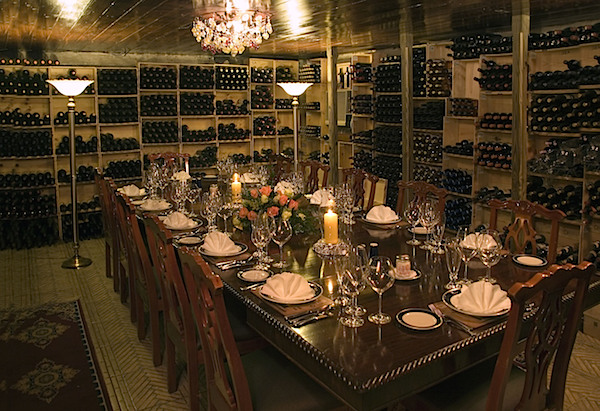 In addition
to chocolate, the Graycliff restaurant (left) is
justifiably known for its wine cellar, being on
the Wine
Spectator
Grand Award list since 1988. The wine cellar has
an inventory of 250,000 bottles from more than 400
vintners in 15 countries. The inventory ranges
from such wines as an 1865 Château Lafite to the
oldest and one of the most expensive bottles in
the world, a 1727 Rudesheimer Apostelwein from
Bremen Ratskeller in the "Rheinghau" Region,
priced at $200,000. Of course, there’s a large
selection of today's popular vintages that
complement the Bahamian-influenced Continental
cuisine served in the restaurant.
In addition
to chocolate, the Graycliff restaurant (left) is
justifiably known for its wine cellar, being on
the Wine
Spectator
Grand Award list since 1988. The wine cellar has
an inventory of 250,000 bottles from more than 400
vintners in 15 countries. The inventory ranges
from such wines as an 1865 Château Lafite to the
oldest and one of the most expensive bottles in
the world, a 1727 Rudesheimer Apostelwein from
Bremen Ratskeller in the "Rheinghau" Region,
priced at $200,000. Of course, there’s a large
selection of today's popular vintages that
complement the Bahamian-influenced Continental
cuisine served in the restaurant.
Atlantis is
one of Nassau’s premier resorts, with a full range
of activities, including a water park for families,
Aquaventure, and the privileged access adult-only
pool area, Cain at the Cove. It includes private
cabanas, daybeds, a café and an outdoor gaming
pavilion. If there’s ever a place to let down your
hair and sip a rum-based beach cocktail or two, this
is it. After all, you’re in the land of “yo-ho-ho
and a bottle of rum."
The restaurant lineup at Atlantis boasts some
big names, including Olives by
chef Todd English.
Our meal at Olives focused on the enticing
raw bar with spiny lobster, oysters and clams. Do
not miss the conch ceviche. The
seafood menu is extensive. Grilled tuna, native
grouper or Florida snapper will satisfy your briny
longings. Of course, steak lovers will also find big
plates like the Tomahawk Ribeye for 2. 
The One &
Only Ocean Club is, relatively, as small
and quiet as the two aforementioned resorts are big
and high energy. Internationally known chef
Jean-Georges Vongerichten designed the menu at Dune (right), an open-air dining room on
the beach known for its French-Asian cuisine infused
with local herbs and Bahamian influences. I enjoyed
only breakfast at Dune, but the dinner menu
features dishes as enticing as crunchy soft shell
crab with sugar snap rémoulade.
No visit to Nassau is complete without a trip
to a rum distillery. John Watling’s
Distillery (below) is an easy walk from the
cruise ship port. Housed in the historic Buena Vista
Estate, founded in 1789, the distillery offers
tastes of its white, pale and amber small-batch
rums. Watling’s daiquiris are masterful.
 West
of downtown, the Fish Fry at Arawak Cay is the
Bahamian version of a food truck park. Rather than
food trailers or vans, however, Fish Fry is an
assemblage of local restaurants and bars serving
very fresh, very authentic Bahamian fare out of
pastel-colored shacks along the waterfront. Many
with outdoor patios, these local eateries beckon
with the aroma of fried shrimp, conch fritters (right) and
grilled lobster tails. You’ll want to join in the
fun while
West
of downtown, the Fish Fry at Arawak Cay is the
Bahamian version of a food truck park. Rather than
food trailers or vans, however, Fish Fry is an
assemblage of local restaurants and bars serving
very fresh, very authentic Bahamian fare out of
pastel-colored shacks along the waterfront. Many
with outdoor patios, these local eateries beckon
with the aroma of fried shrimp, conch fritters (right) and
grilled lobster tails. You’ll want to join in the
fun while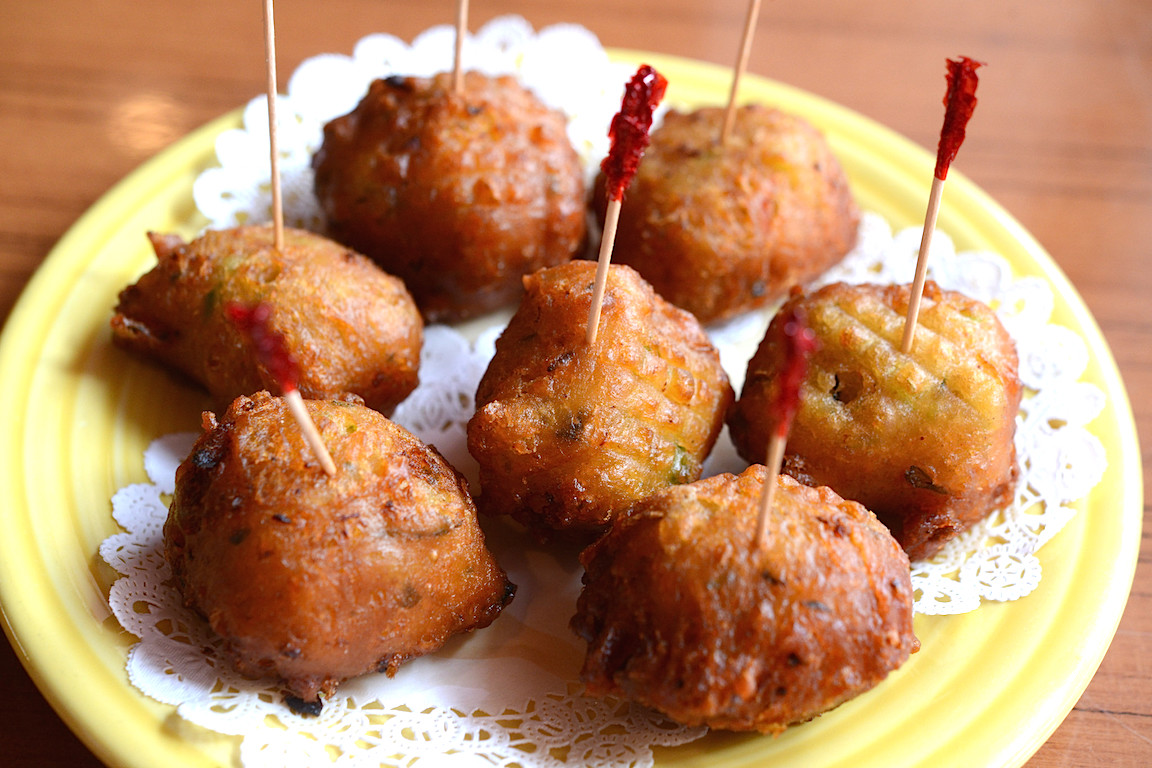 sipping a
local Kalik beer or experiencing a Sky Juice
cocktail, a mix of gin, coconut water and sweetened
condensed milk. I didn’t experience Sky Juice till
near the end of my Nassau stay. Probably a good
thing but still a source of lingering regret.
sipping a
local Kalik beer or experiencing a Sky Juice
cocktail, a mix of gin, coconut water and sweetened
condensed milk. I didn’t experience Sky Juice till
near the end of my Nassau stay. Probably a good
thing but still a source of lingering regret.
Whether you’re in Nassau for
quiet fun in the sun, pampering at myriad spas,
water adventures and sports, or sightseeing and
history, the dining and food options are a big part
of the experience.
If, like me, you’re a Black Sails
follower, you’ll get a better understanding of the
Old World fascination and avarice that made the
islands of the Caribbean a colonial grail.
❖❖❖
By John Mariani
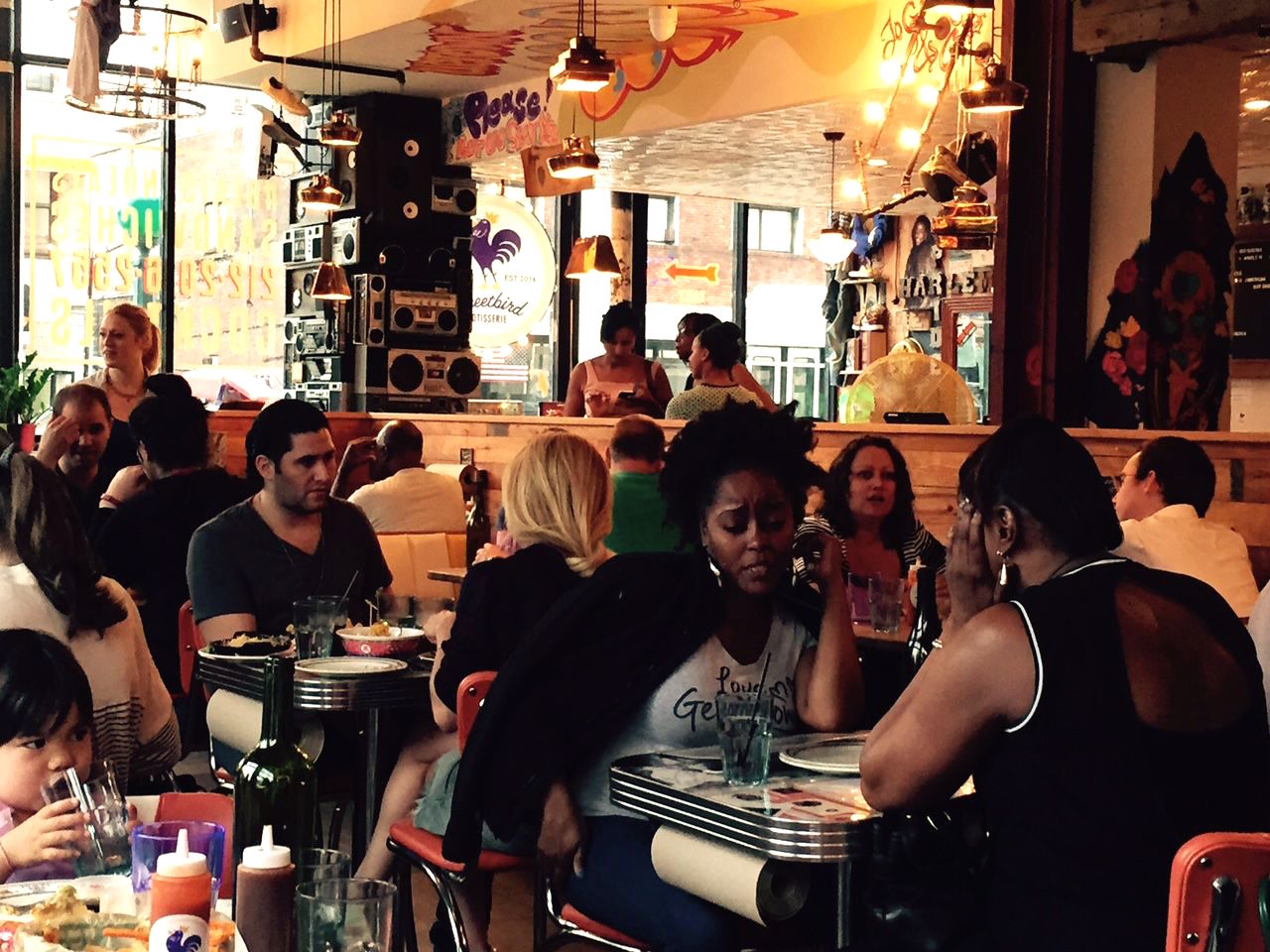 Streetbird ROTISSERIE
Streetbird ROTISSERIE2149 Frederick
Douglass Boulevard (at 116th Street)
212-206-2557
www.streetbirdnyc.com
The best
thing I had at Streetbird Rotisserie was the
bloody Mary ($9)--here called “Sippin’ on Tomato
Juice”--which I do not mean as faint praise. For
this was by far the very best Bloody Mary I’ve
ever tasted, spiked with Streetbird Hot Sauce. So, if not
everything else on the menu came up to that
level, a lot of the food at this very casual
corner eatery in Harlem was good fun, not least
the “Return of the Mac,” a mac-and-cheese dish
of rigatoni lavished with cheddar and Parmesan,
then sent out crisp on top and bubbling inside (right).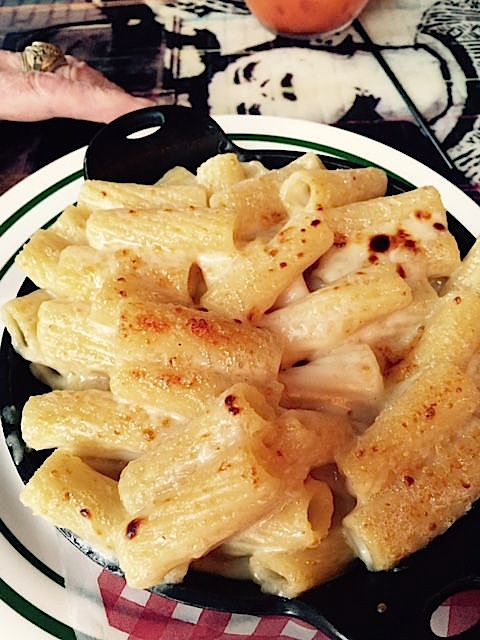
They like to play on words
here, not least the restaurant’s title, which is a
turn on the Southern country term "yard bird," for
chicken. Indeed,
many of the items sound like those you’d find in
the kind of eatery Guy Fieri visits, with names
like “Hot & Messy,” “Mash It Up Potatoes,”
“Tick Tack” and “Ying & Yang Fries.”
Streetbird Rotisserie is one of
celebrity chef Marcus Samuelsson’s enterprises,
along with Red Rooster (also in Harlem), Norda Bar
& Grill in Gothenburg, Sweden, and, as of
this month, Marcus in Bermuda. I note
Samuelsson’s celebrity status because these days
he seems to have become more of a fashion plate
than a presence in his kitchens. His
story is well known: Born in Ethiopia, adopted by
Swedish parents and raised in Scandinavia, he made
his rep in NYC for haute Scandinavian cuisine at
Aquavit before leaving to open, and quickly close,
an African restaurant in Manhattan. Red
Rooster was a leap of faith by locating in Harlem
just as that long-troubled neighborhood was
gaining some traction and, now, gentrification,
and the restaurant has had an admirable part in
that.
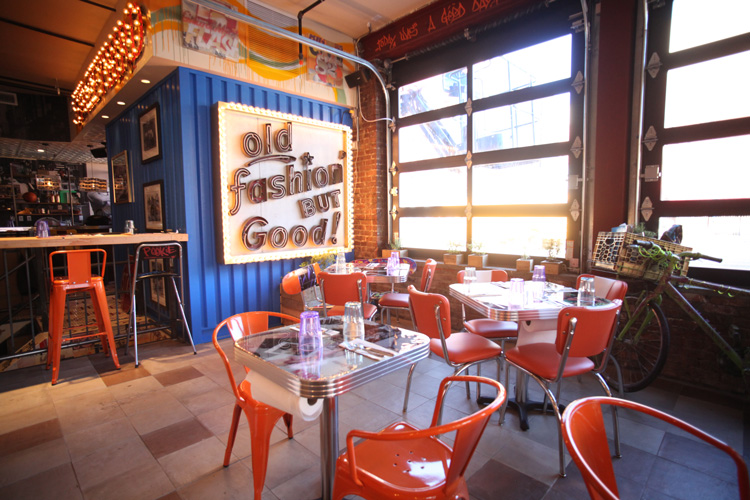 Red
Rooster’s menu was largely Southern soul food,
whereas Streetbird Rotisserie’s is all over the
globe, with dishes like “Swediopian” ($12.50) made
of Ethiopian doro wat
and injera
with cheese, eggs and greens. There
are “Block Party” items like “Bruce LeRoy
sandwich” ($11), named after a black kung-fu
actor. And
a whole lot of chicken--“Bird Land”-- from the
large open rotisserie.
Red
Rooster’s menu was largely Southern soul food,
whereas Streetbird Rotisserie’s is all over the
globe, with dishes like “Swediopian” ($12.50) made
of Ethiopian doro wat
and injera
with cheese, eggs and greens. There
are “Block Party” items like “Bruce LeRoy
sandwich” ($11), named after a black kung-fu
actor. And
a whole lot of chicken--“Bird Land”-- from the
large open rotisserie.
The 68-seat room is a riot of
colors and art inspired by hip hop and street
culture of the 1970s and 1990s, including graffiti
by Cey Adams, a floor collage of Harlem life by
Anthony Vasquez, old boom boxes, West African
fabrics, church pews, quilted stainless steel,
white subway tiles, lighting fixtures made from
cassette tapes, and a subway door, all of which
makes the place an instant micro-museum of Harlem
history. It
also makes it a very, very loud place to eat. Best
bet is to try to snare a table by an open window
on 116th Street, where you can also watch modern
street life pass by.
The kitchen is overseen by Chef
Adrienne Cheatham. They take no reservations but
the charming women at the host station will do
everything to make your wait and evening
enjoyable.
The menu is a folded piece of
paper (take-out on the back), which also contains
a wine list of 15 bottlings (only two under $42)
and eight beers, along with house cocktails.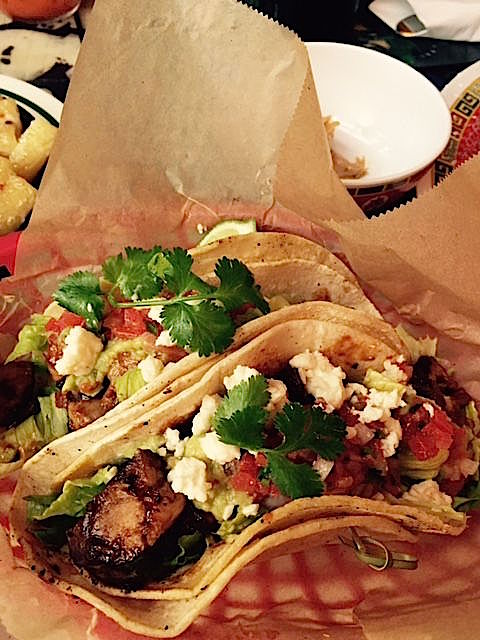
The prices for large portions
of food are easy to digest, with a whole
rotisserie chicken at $18, half at $9.50, and
chicken and waffles $12.50 (the same dish at an
assembly line IHop costs $9.49).
On a recent summer evening our
party tucked into a pork taco ($8.50), which for
some reason encases the meat, pico de gallo,
guacamole, white cheese, and cilantro within two
taco shells (right).
It was okay, not radically different from one of
the neighborhood’s better taco shops. Hot
& Messy ($12.50) certainly lived up to its
name--a pile-on of toasted cornbread (a little
dry), pulled chicken, fried egg, avocado, peanut
butter and bacon. What’s not to like?
Blackened catfish with chutney
and white cheddar grits ($14.50) was a good dish,
if somewhat overcooked, and the Americano ($12.50)
was a bland frittata with pulled chicken, crispy
bread and pickled onions (below), which could really use
some of that hot sauce.
We ordered the whole rotisserie
chicken, which was well cooked but the flavor of
the chicken itself was nothing special, about what
one might expect from Costco, which sells a better
seasoned bird.
It also didn’t have that sizzle as a bird
straight off the skewer should.
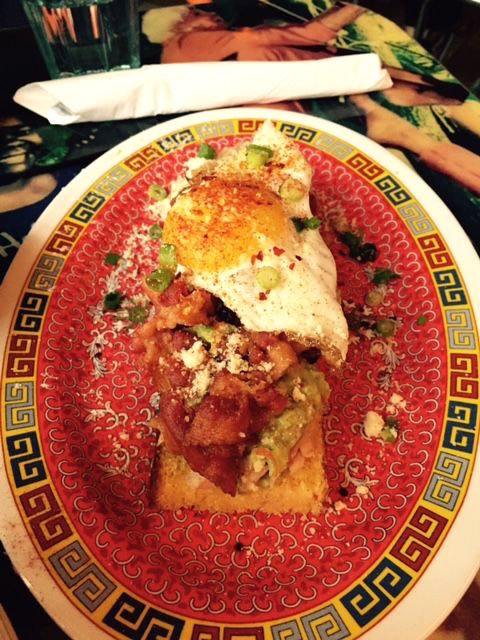 Ying
& Yang Fries ($4) made from sweet potatoes and
garlic fries with Parmesan were seriously
addictive at our table, and the Mash It Up
Potatoes ($5) came in a close second.
Ying
& Yang Fries ($4) made from sweet potatoes and
garlic fries with Parmesan were seriously
addictive at our table, and the Mash It Up
Potatoes ($5) came in a close second.
Oddly, there are only two
desserts on the menu, and on the night we were
there only one was offered--a big chocolate-peanut
cookie with toasted marshmallows ($3) that
amounted to a guilty pleasure.
One might expect a bit more
culinary innovation from someone of Samuelsson’s
credentials, but, overall, Streetbird Rotisserie
should not be taken too seriously; it is what it
intends to be, a local drop-in kind of joint with
a diner-like menu and a whole lot of good vibes.
Streetbird Rotisserie
is open seven days a week from 11:30 am through
10:00 pm. Tables are available for
walk-ins only and there is a separate section
for take-out only.
❖❖❖
NOTES FROM THE WINE CELLAR
PINE RIDGE COMES TO NYC TO SHOW ITS
BEST
By Mort Hochstein
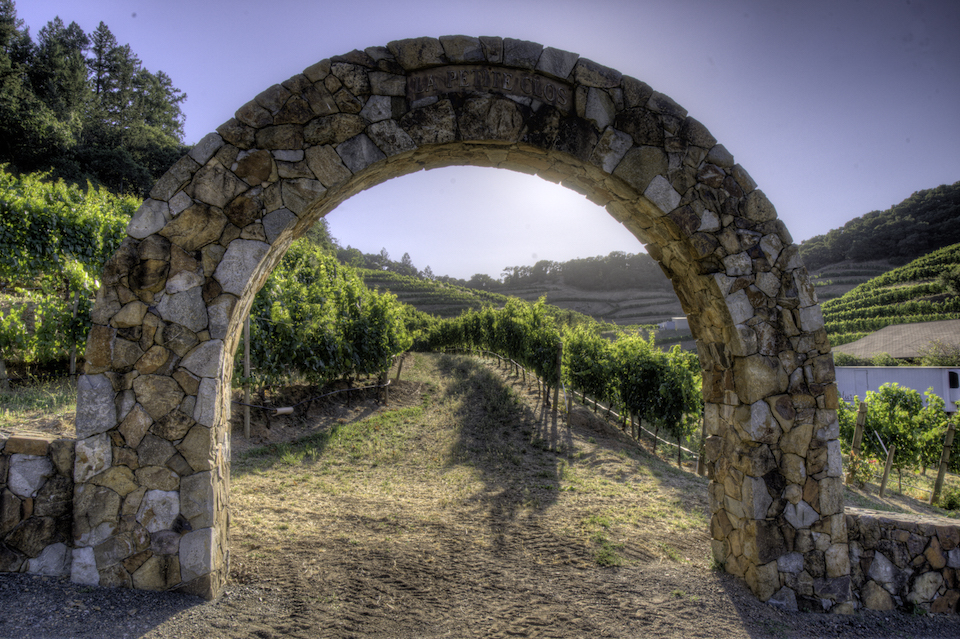 The
servers, one in a brown suit, three others in gray,
wafted around noiselessly, plates appearing on the
table almost unobserved. It was, after all, Per Se, one
of New York’s most prestigious, most expensive
dining temples. The
people at Pine Ridge Vineyards
chose it for a tasting of their wines because even
the most jaded members of the wine media would find
it hard to say no to an evening at Per Se.
The
servers, one in a brown suit, three others in gray,
wafted around noiselessly, plates appearing on the
table almost unobserved. It was, after all, Per Se, one
of New York’s most prestigious, most expensive
dining temples. The
people at Pine Ridge Vineyards
chose it for a tasting of their wines because even
the most jaded members of the wine media would find
it hard to say no to an evening at Per Se.
So
it was that a dozen journalists assembled on a warm
summer evening under the tutelage of Michael
Beaulac, winemaker and general manager for Pine
Ridge, one of the fortunate few on the hallowed
slopes of the Stags Leap district in Napa.
Pine
Ridge originated in 1978 under the far-sighted Gary
Andrus at a time when few recognized the bounty to
be harvested at Stags Leap. He saw a
steeply terraced hillside where he might be able to
produce wines comparable with the greats of Bordeaux
and went on to realize that goal over the next 15
years. Andrus also had another goal, to produce
great Pinot Noir,
and for that
he had to go farther north. He left
California in 1993 for Oregon, where he would create
award-winning wines at Archery Summit. Andrus,
now deceased, sold his interests in California and
Oregon in 2001. 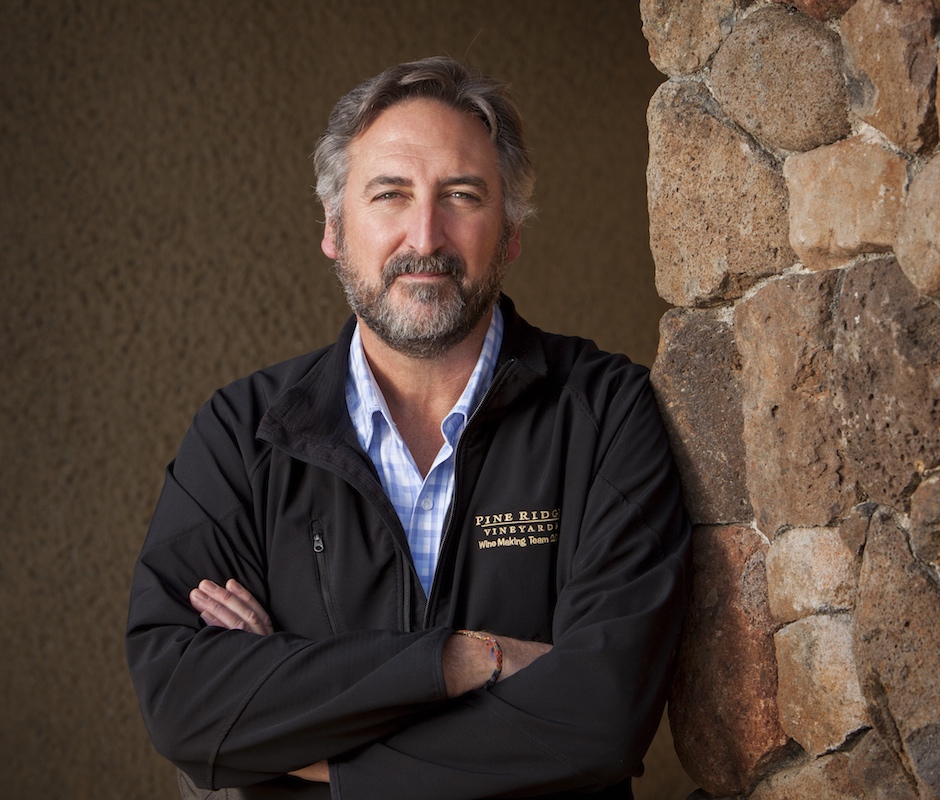
Michael
Beaulac, not academically schooled in viticulture, learned
his craft the
hard way, swabbing
tanks, loading
barrels and hefting hoses as a cellar rat at
Murphy-Goode Vineyards in Napa. He had
been a wine buyer for a supper club in Portland,
Maine, where Tim Murphy of Murphy-Goode, impressed
by the young steward’s palate, jokingly offered him
a job. A year after that chance remark, Beaulac
began his wine career, doing scut work in Napa.
“I'd been a history major in college and knew
nothing,” he said. “I needed to learn how to hook up
a hose and clean a tank. I didn’t know there was a
difference in how you made white wine from how you
made red wine. Each day I came in thinking I would
be fired."
The
experience at Murphy-Goode led up the ladder to
advanced positions and executive postings at Markham
Vineyards and St. Supery and in 2009 to Pine Ridge.
“For me,” he said, “a lot of winemaking is
intuitive, and at this time I can taste a berry and
anticipate where that grape will be during
fermentation. But a lot is chemistry and I’ve always
been really lucky to have great enologists and
assistant winemakers who can identify issues. Now I
can review the analysis and see what I need to see,
but for a long time I didn’t understand the stuff.”
We tasted Beaulac’s first vintage, the 2009 Stags Leap
Cabernet Sauvignon, a rich mouth-filling
wine with supple black fruit flavors, absolutely
luxurious and with many good years ahead. It is
still available at suggested retail price of $125.
It’s a keeper, easily good for another ten years.
We had started with the wine that keeps the
wheels spinning
at Pine Ridge, the Chenin Blanc-Viognier, with 20%
Chenin adding sparkle to the Viognier’s peach and
jasmine scents and providing a more enticing palate
taste. The
grapes come from
the Sacramento River Delta and make up the
only non-estate wine in the portfolio. It is the
darling of Pine Ridge, selling 145,000 cases
annually, retailing at about $15 a bottle.
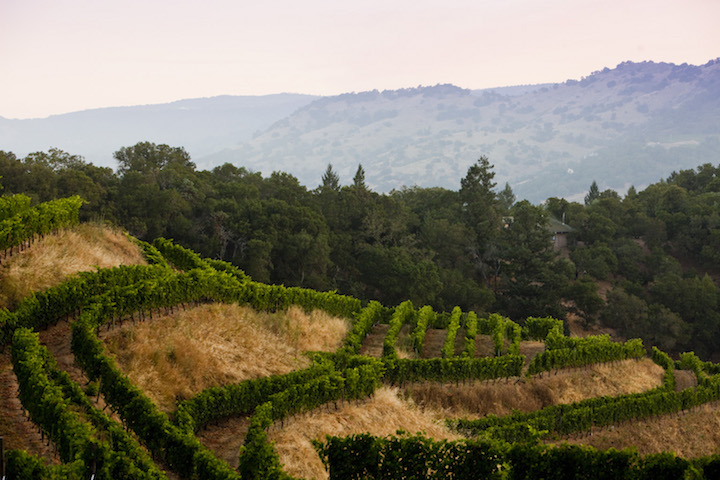 The
blend was the value wine at the tasting and was
followed by the much more upscale Le Petit Clos 2013
Chardonnay ($75). The Chardonnay comes from a
small block, a shade under two acres, on a hillside
near the winery.
Grapes are hand harvested at night in early
September for optimum ripeness.
The
blend was the value wine at the tasting and was
followed by the much more upscale Le Petit Clos 2013
Chardonnay ($75). The Chardonnay comes from a
small block, a shade under two acres, on a hillside
near the winery.
Grapes are hand harvested at night in early
September for optimum ripeness.
Le Petit
Clos is a lemony, creamy wine with slight minerality
and a bit more oak than I would prefer and an almost
alarming, but well masked, 14.9% alcohol level. It
harmonized beautifully with my favorite plate of the
evening, two poached oysters in a thick
sabayon-style sauce, topped by a generous smattering
of domestic caviar.
The rich purple 2009 Cabernet ($125) was mated with
Atlantic striped bass dressed with smoked bacon,
summer pole beans, and a Dijonnaise
sauce--delectable, albeit a bit precious. Plates
were whisked away and the meat course appeared,
a small serving of Prime beef with caramelized
onions and a few dabs of mustard and molasses.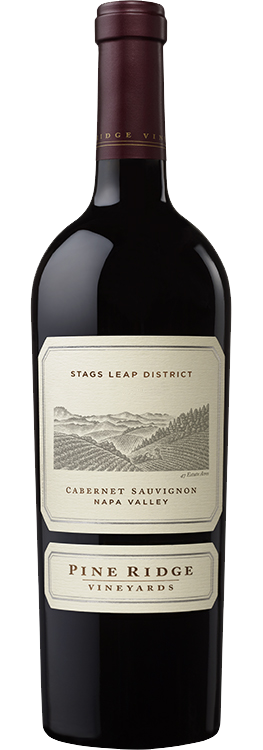 It set
the stage for the second red wine, the 2012 Stags Leap Cab ($125),
which at this tender age lacks the finesse of the
2009, hardly as smooth and silken and needing more
time.
It set
the stage for the second red wine, the 2012 Stags Leap Cab ($125),
which at this tender age lacks the finesse of the
2009, hardly as smooth and silken and needing more
time.
It was followed by the Pine Ridge 2012 Napa
label ($54), from a number of the winery’s own
estates in the Napa Valley, Oakville, and Rutherford
districts. It’s
somewhat lighter in color and texture than the Stags
Leap bottlings, but definitely a match for hearty
dishes such as steak, lamb or even, as Beaulac
suggested, a cheeseburger. There’s a bit of cinnamon
on the palate, a flavor I did not find in the Stags
Leap reds. Here, the wine showed well with a Bleu
D’Auvergne cheese plate that included tiny bits of
potato crusted leek, Bing cherries, sorrel and a
black winter truffle puree.
In an odd
but comfortable pairing, Beaulac saved Fortis 2012, the
company’s heavyweight red, for the dessert stage. It
accompanied the fancifully named Manjari
Chocolate Marquise, a combo of burnt honey ice cream
and butterscotch plated with candied orange peel and
a Darjeeling tea biscuit. Fortis ($175) originated
in 2003 to show off grapes from the finest blocks of
the Pine Ridge estate vineyards in Napa.
Fortis
is by design a big wine, an elegant Bordeaux blend,
14.5% alcohol, primarily Cabernet Sauvignon with 11%
Petit Verdot and 5% Malbec. The grapes vary with
each vintage. In 2012, the fruit came primarily from
Stags Leap, Oakville and Howell Mountain, with a
smaller amount from Rutherford. Although it is a far
different blend, the Fortis, only slightly more
complex, was very much like the 2009 Stags Leap,
plush and dark with black fruit flavors. I preferred
the 2009 Stags Leap but it would have been
interesting to try Fortis with its true mate, good
red beef. Again,
a few more years of maturity would change the wine
favorably.
The flagship reds are all limited production
wines, often hard to find. The winery produces about
1,100 cases of the Stags Leap label each year, a
little more than 1,000 cases of Fortis and 12,000
cases of the Napa blend.
❖❖❖
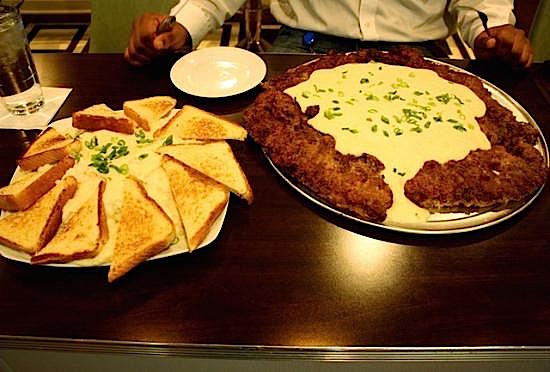 PAULA DEEN WILL BE
PAULA DEEN WILL BE
According
to DailyMeal.com, The Cowtown Diner in Fort Worth, TX,
is home to the world’s largest chicken-fried steak (left), and if you
finish the 64-ounces of meat drenched in white gravy and
bacon grease, with six pounds of mashed potatoes and 10
slices of Texas toast, your meal is comped, and you get
a T-shirt and a picture on the wall.
ANSWERS
WE DOUBT ANY
WELL-TRAVELED CHEFS GAVE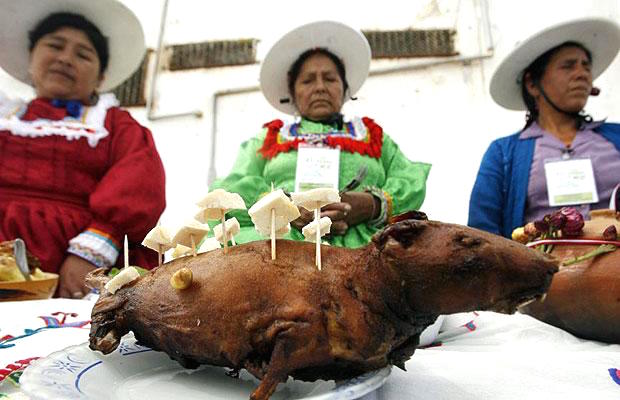
“Ask any
well-traveled chefs to name their favorite culinary
destination, and more often than not the answer will be
Peru.”—James Beard
Events (July/August 2015)
Any of John Mariani's books below may be ordered from amazon.com.
 I'm proud and happy to announce that my
new book, The Hound
in Heaven (21st Century Lion Books), has just
been published through Amazon and Kindle.
I'm proud and happy to announce that my
new book, The Hound
in Heaven (21st Century Lion Books), has just
been published through Amazon and Kindle. It is a novella, and for anyone who loves dogs, Christmas, romance, inspiration, even the supernatural, I hope you'll find this to be a treasured favorite. The story concerns how, after a New England teacher, his wife and their two daughters adopt a stray puppy found in their barn in northern Maine, their lives seem full of promise. But when tragedy strikes, their wonderful dog Lazarus and the spirit of Christmas are the only things that may bring back his master back from the edge of despair.
WATCH THE VIDEO!
“What a huge surprise turn this story took! I was completely stunned! I truly enjoyed this book and its message.” – Actress Ali MacGraw
“He had me at Page One. The amount of heart, human insight, soul searching, and deft literary strength that John Mariani pours into this airtight novella is vertigo-inducing. Perhaps ‘wow’ would be the best comment.” – James Dalessandro, author of Bohemian Heart and 1906.
“John Mariani’s Hound in Heaven starts with a well-painted portrayal of an American family, along with the requisite dog. A surprise event flips the action of the novel and captures us for a voyage leading to a hopeful and heart-warming message. A page turning, one sitting read, it’s the perfect antidote for the winter and promotion of holiday celebration.” – Ann Pearlman, author of The Christmas Cookie Club and A Gift for my Sister.
“John Mariani’s concise, achingly beautiful novella pulls a literary rabbit out of a hat – a mash-up of the cosmic and the intimate, the tragic and the heart-warming – a Christmas tale for all ages, and all faiths. Read it to your children, read it to yourself… but read it. Early and often. Highly recommended.” – Jay Bonansinga, New York Times bestselling author of Pinkerton’s War, The Sinking of The Eastland, and The Walking Dead: The Road To Woodbury.
“Amazing things happen when you open your heart to an animal. The Hound in Heaven delivers a powerful story of healing that is forged in the spiritual relationship between a man and his best friend. The book brings a message of hope that can enrich our images of family, love, and loss.” – Dr. Barbara Royal, author of The Royal Treatment.
 |
The Encyclopedia of American Food and Drink by John F. Mariani (Bloomsbury USA, $35) Modesty forbids me to praise my own new book, but let me proudly say that it is an extensive revision of the 4th edition that appeared more than a decade ago, before locavores, molecular cuisine, modernist cuisine, the Food Network and so much more, now included. Word origins have been completely updated, as have per capita consumption and production stats. Most important, for the first time since publication in the 1980s, the book includes more than 100 biographies of Americans who have changed the way we cook, eat and drink -- from Fannie Farmer and Julia Child to Robert Mondavi and Thomas Keller. "This book is amazing! It has entries for everything from `abalone' to `zwieback,' plus more than 500 recipes for classic American dishes and drinks."--Devra First, The Boston Globe. "Much needed in any kitchen library."--Bon Appetit. |
"Eating Italian will never be the same after reading John Mariani's entertaining and savory gastronomical history of the cuisine of Italy and how it won over appetites worldwide. . . . This book is such a tasteful narrative that it will literally make you hungry for Italian food and arouse your appetite for gastronomical history."--Don Oldenburg, USA Today. "Italian
restaurants--some good, some glitzy--far
outnumber their French rivals. Many of
these establishments are zestfully described
in How Italian Food Conquered the World, an
entertaining and fact-filled chronicle by
food-and-wine correspondent John F.
Mariani."--Aram Bakshian Jr., Wall Street
Journal.
"Equal parts
history, sociology, gastronomy, and just
plain fun, How Italian Food Conquered the
World tells the captivating and delicious
story of the (let's face it) everybody's
favorite cuisine with clarity, verve and
more than one surprise."--Colman Andrews,
editorial director of The Daily
Meal.com. "A fantastic and fascinating
read, covering everything from the influence
of Venice's spice trade to the impact of
Italian immigrants in America and the
evolution of alta cucina. This book will
serve as a terrific resource to anyone
interested in the real story of Italian
food."--Mary Ann Esposito, host of PBS-TV's
Ciao
Italia. "John Mariani has written the
definitive history of how Italians won their
way into our hearts, minds, and
stomachs. It's a story of pleasure over
pomp and taste over technique."--Danny Meyer,
owner of NYC restaurants Union Square
Cafe, The Modern, and Maialino.
|
 |
 |
 |
 |
 |
 |
 |
 |
 Everett Potter's Travel Report:
Everett Potter's Travel Report: 
 Eating Las
Vegas is the new on-line site for
Virtual Gourmet contributor John A. Curtas.,
who since 1995 has been commenting on the
Las Vegas food scene and reviewing
restaurants for Nevada Public Radio.
He is also the restaurant critic for KLAS
TV, Channel 8 in Las Vegas, and his past
reviews can be accessed at KNPR.org.
Click on the logo below to go directly to
his site.
Eating Las
Vegas is the new on-line site for
Virtual Gourmet contributor John A. Curtas.,
who since 1995 has been commenting on the
Las Vegas food scene and reviewing
restaurants for Nevada Public Radio.
He is also the restaurant critic for KLAS
TV, Channel 8 in Las Vegas, and his past
reviews can be accessed at KNPR.org.
Click on the logo below to go directly to
his site.

Tennis Resorts Online: A Critical Guide to the World's Best Tennis Resorts and Tennis Camps, published by ROGER COX, who has spent more than two decades writing about tennis travel, including a 17-year stretch for Tennis magazine. He has also written for Arthur Frommer's Budget Travel, New York Magazine, Travel & Leisure, Esquire, Money, USTA Magazine, Men's Journal, and The Robb Report. He has authored two books-The World's Best Tennis Vacations (Stephen Greene Press/Viking Penguin, 1990) and The Best Places to Stay in the Rockies (Houghton Mifflin, 1992 & 1994), and the Melbourne (Australia) chapter to the Wall Street Journal Business Guide to Cities of the Pacific Rim (Fodor's Travel Guides, 1991).


MARIANI'S VIRTUAL GOURMET
NEWSLETTER is published weekly. Editor/Publisher: John
Mariani.
Editor: Walter Bagley. Contributing Writers: Christopher Mariani,
Robert Mariani, Misha
Mariani,
John A. Curtas, Edward Brivio, Mort Hochstein,
Andrew Chalk, Dotty Griffith and Brian Freedman. Contributing
Photographers: Galina Dargery, Bobby
Pirillo. Technical Advisor: Gerry McLoughlin.
To un-subscribe from this newsletter,click here.
© copyright John Mariani 2015

